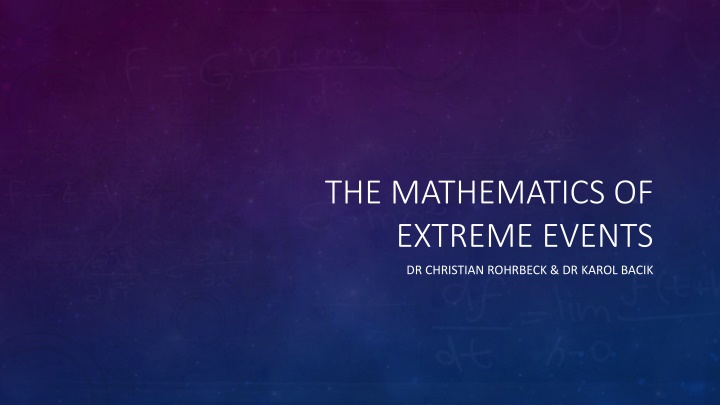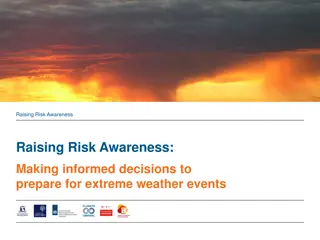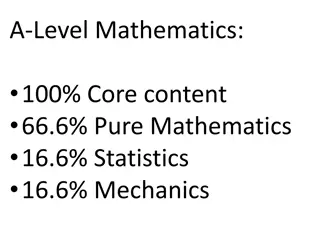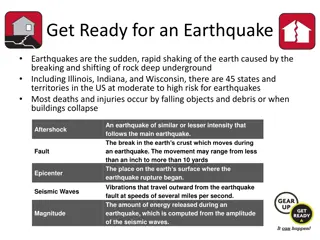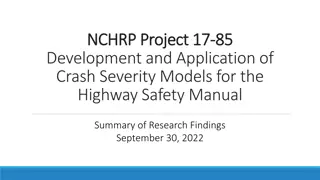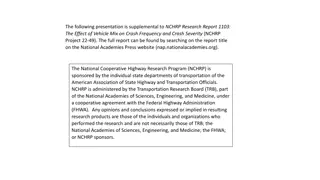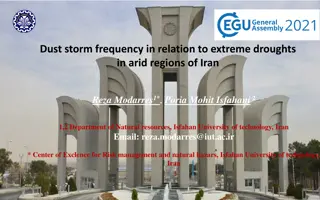The Mathematics of Extreme Events: Understanding Frequency and Severity
In the book "The Mathematics of Extreme Events" by Dr. Christian Rohrbeck & Dr. Karol Bacik, the concepts of extreme events such as white Christmases, river flow analysis, and earthquake frequency are explored. The aim is to introduce models for predicting the occurrence and severity of such events. By studying probabilities and averages, the book delves into estimating the likelihood of future extreme events. Through examples and calculations, readers gain insights into how these models can be applied in various scenarios.
Download Presentation

Please find below an Image/Link to download the presentation.
The content on the website is provided AS IS for your information and personal use only. It may not be sold, licensed, or shared on other websites without obtaining consent from the author.If you encounter any issues during the download, it is possible that the publisher has removed the file from their server.
You are allowed to download the files provided on this website for personal or commercial use, subject to the condition that they are used lawfully. All files are the property of their respective owners.
The content on the website is provided AS IS for your information and personal use only. It may not be sold, licensed, or shared on other websites without obtaining consent from the author.
E N D
Presentation Transcript
THE MATHEMATICS OF EXTREME EVENTS DR CHRISTIAN ROHRBECK & DR KAROL BACIK
WHAT ARE WE INTERESTED IN? How often do these extremes happen, aka frequency? For some cases, we can calculate it exactly: The chance to win the lottery is 1 in 45,057,474. However, we have to estimate the frequency in many situations. We also have to predict the severity of an extreme event: What is the wind speed our house has to withstand? How high may flood levels be in the next 100 years?
WHAT ARE WE INTERESTED IN? Recorded River Flow for the River Avon at Bathford between 1970 and 2020
AIM OF THIS CLASS We will introduce two models for the frequency of an extreme event. These models help to address questions such as How many years until the next white Christmas? How many earthquakes are recorded worldwide within a year? We also consider the estimation of these models
HOW MANY YEARS UNTIL THE NEXT WHITE CHRISTMAS? Let p p be the probability of a white Christmas in any considered year. Suppose that we just experienced a white Christmas. The probability that we have to wait 1 year is p p. Snow again next year The probability that we have to wait 2 years is (1 No snow next year and Snow the year after (1- -p) * p p) * p. The probability that we have to wait 3 years is (1 No snow in Year 1 and No snow in Year 2 and Snow in Year 3 (1- -p) * (1 p) * (1- -p) * p p) * p.
HOW MANY YEARS UNTIL THE NEXT WHITE CHRISTMAS? We find that the probability that we have to wait k =1,2,3,.. years is ?(1 ?)? 1 For South-West England, a white Christmas was recorded for the following years 1961, 1964, 1970, 1981, 1985, 1990, 1993, 1995 1996, 1999, 2000, 2001, 2004, 2013 How can we estimate the probability p the probability p ?
HOW MANY YEARS UNTIL THE NEXT WHITE CHRISTMAS? To estimate p p, we can perform the following two steps: 1. Calculate the average time between consecutive white Christmases For South-west England, the number of years between white Christmases were 3, 6, 11, 4, 5, 3, 2, 1, 3, 1, 1, 3 and 9 So the average number of years between white Christmases was 52 / 13 = 4. 2. The estimate for the probability p p is then (1 / average time calculated in Step 1) So our estimate for p p is 1 / 4 = 0.25.
NUMBER OF EARTHQUAKES WORLDWIDE The United States Geological Survey provides the number of earthquakes over the past 32 years. Light colours indicate the earthquakes with a magnitude between 7.0 and 8.0, and darker colours are earthquakes above 8.0 on the Richter scale.
NUMBER OF EARTHQUAKES WORLDWIDE Interest lies in modelling the yearly number of earthquakes with a magnitude of 7.0 or above A popular model for counts defines the probability that we will record k =0,1,2,3,.. =0,1,2,3,.. earthquakes as ?? ?! exp ? , where the parameter q > 0 is unknown.
NUMBER OF EARTHQUAKES WORLDWIDE We can estimate q as the average number of earthquakes within in a year. For the given data, we estimate q as 15.1. The plot on the right shows the probabilities for the different values of k. This model allows for any positive count, even 10,000,000.
EXERCISE 1 Consider the modelling of heatwaves (these are extended periods of hot weather). Which aspects may we be interested in modelling? Hint: Remember the concepts of frequency and severity. 1) How often do heatwaves occur? -> Frequency 2) How long are the heatwaves in days? -> Severity 3) How high will the temperatures be? -> Severity
EXERCISE 2 For the River Avon at Bathford, a river flow above 180 m^3/s was recorded in 1972, 1979, 1985, 1989, 1995, 1999, 2000, 2002, 2008, 2009, 2012 and 2013 1. Using one of the methods introduced today, calculate the probability p p that the river flow exceeds 180 m^3/s in a year. 2. What is the estimated probability that the next time the river flow exceeds 180 m^3/s is in 2024? 3. Do you think it is reasonable to assume that p p is constant between 1972 and 2013?
EXERCISE 3 We are interested in modelling the number of periods with extreme heat for the city of Dresden in Germany. The total number of heatwaves for the years 2000 to 2018 was 36. 1. Define a model for the number of heatwaves within a year and estimate any unknown model parameters. 2. What is the probability that the number of heatwaves in a year is less than 2? 3. What is the probability that there is at least 1 heatwave in a year?
